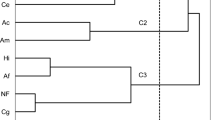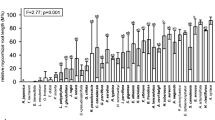Abstract
The mycorrhizal status of water-impounding “tank” bromeliad epiphytes from three locales differing in altitude and moisture regime within Venezuelan cloud forest was examined. Species of vesicular-arbuscular mycorrhizal (VAM) fungi found in arboreal soils were compared to VAM fungi found in terrestrial soils. Sixteen of the 19 epiphytes examined for the presence of VAM fungi had roots with infection stages; 14 of these specimens showed growth of the fine endophyte Glomus tenue. Fine endophyte was the only VAM fungus found associated with epiphytes in the driest locale studied, while coarse VAM fungi (Gigaspora and Scutellospora spp.) were found at sampling locales receiving more moisture. Root infection was usually composed of intercellular hyphae and peletons; few arbuscules were observed. However, abundant extracellular hyphae were often observed tangled about roots in arboreal soil. It is concluded that epiphytic bromeliads probably benefit, at least periodically, from VAM fungi scavenging for sporadically available nutrients in arboreal soils. Glomus tenue may be particularly important as a colonizing VAM fungus in drier sites of Venezuelan cloud forest. The species composition of VAM fungi in arboreal soils was different to that of terrestrial soils sampled directly under epiphytic bromeliad perches, suggesting that VAM fungi species associated with bromeliads are dispersed to their hosts by vagile animal vectors.
Similar content being viewed by others
References
Aziz T, Yuen JE, Habte M (1990) Response of pineapple to mycorrhizal inoculation and fosetyl-al treatment. Commun Soil Sci Plant Anal 21:2309–2317
Baylis GTS (1967) Experiments on the significance of phycomycetous mycorrhizas. New Phytol 66:231–243
Beebe W, Crane J (1947) Ecology of Rancho Grande. Zoologica 32:43–60
Benzing DH (1980) The biology of the bromeliads. Mad River Press, Eureka, Calif
Daft MJ, Nicolson TH (1974) Arbuscular mycorrhizas in plants colonizing coal wastes in Scotland. New Phytol 73:1129–1138
Ewel JJ, Madriz A (1968) Zonas de vida de Venezuela. Direccion de Investigacion, Ministerio de Agricultura y Cria, Caracas, Venezuela
Hall IR (1977) Species and mycorrhizal infections of New Zealand Endogonaceae. Trans Br Mycol Soc 68:341–356
Huber O (1986) La Selva nublada de Rancho Grande Parque Nacional Henri Pittier. In: Pittier H, Huber O (eds). Fondo Editorial Acta Cientifica Venezolana, Quito, Ecuador, pp 1–15
Johnson PN (1977) Mycorrhizal Endogonaceae in a New Zealand forest. New Phytol 78:161–170
Lesica P, Antibus RK (1990) The occurrence of mycorrhizae in vascular epiphytes of two Costa Rican rain forests. Biotropica 22:250–258
Maffia B, Nadkarni NM, Janos DP (1993) Vesicular-arbuscular mycorrhizae of epiphytic and terrestrial Piperaceae under field and greenhouse conditions. Mycorrhiza 4:5–9
Mosse B (1981) Vesicular-arbuscular mycorrhiza research fortropical agriculture. (University of Hawaii Research Bulletin 194) Hawaii Institute of Agriculture and Human Resources, Honolulu
Paoletti M, Taylor RAJ, Stinner BR, Stinner DH, Benzing DH (1991) Diversity of soil fauna in the canopy and forest floor of a Venezuelan cloud forest. J Trop Ecol 7:373–383
Phillips JM, Hayman DS (1970) Improved procedures for clearing and staining parasitic and vesicular-arbuscular mycorrhizal fungi for rapid assessment of infection. Trans Br Mycol Soc 55:158–161
Powell CL, Daniel J (1978) Mycorrhizal fungi stimulate uptake of a soluble and insoluble phosphate fertilizer from a phosphate deficient soil. New Phytol 80:351–358
Rabatin SC (1980) The occurrence of the vesicular-arbuscular mycorrhizal fungus Glomus tenuis with moss. Mycologia 72:191–195
Rabatin SC, Stinner BR (1988) Indirect effects of interactions between VAM fungi and soil-inhabiting invertebrates on plant processes. In: Edwards CA, Stinner BR, Stinner DH, Rabatin SC (eds) Biological interactions in soil. Elsevier, New York, pp 135–146
Rabatin SC, Stinner BR (1991) Vesicular-arbuscular mycorrhizae, plant and invertebrate interactions in soil. In: Barbosa P, Krischik V, Jones CG (eds) Microbial mediation of plant-herbivore interactions. Wiley, New York, pp 141–168
Reddell P, Spain A (1991) Earthworms as vectors of viable propagules of mycorrhizal fungi. Soil Biol Biochem 23:767–774
Reitz R (1983) Bromeliaceas e a malaria-bromelia endemica. Itajai, Santa Catarina, Brasil
Schenck N, Perez Y (1987) Manual for the identification of VA mycorrhizal fungi. International culture collection of VA mycorrhizal fungi. University of Florida Publishers, Gainesville, Fla
Author information
Authors and Affiliations
Rights and permissions
About this article
Cite this article
Rabatin, S.C., Stinner, B.R. & Paoletti, M.G. Vesicular-arbuscular mycorrhizal fungi, particularly Glomus tenue, in Venezuelan bromeliad epiphytes. Mycorrhiza 4, 17–20 (1993). https://doi.org/10.1007/BF00203245
Issue Date:
DOI: https://doi.org/10.1007/BF00203245




